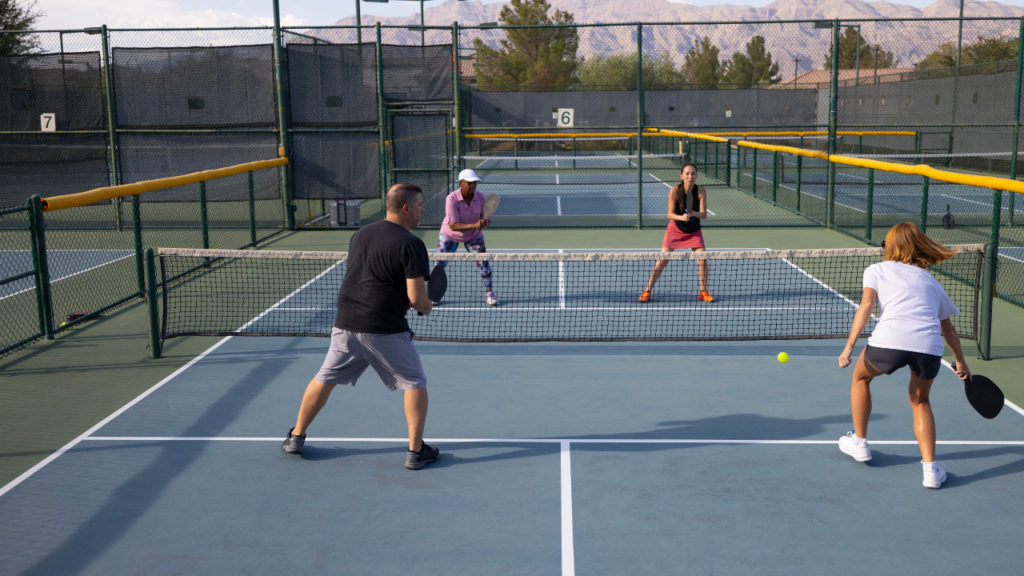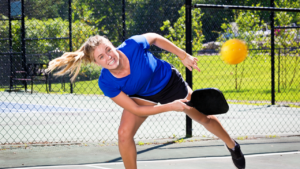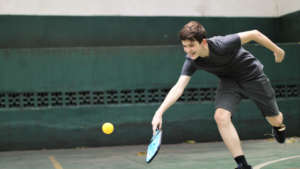
Pickleball footwork drills are key to improving your game. They help you move faster, react better, and hit with more power. Mastering these drills boosts your agility and balance on the court. You’ll be ready for any shot that comes your way. Incorporating fun and effective exercises into your routine makes practice enjoyable. Whether you’re a newbie or a pro, these drills will level up your skills. Scroll down for reviews of our top picks that will take your footwork to the next level!
Table of Contents
Key Takeaways
- Practice the Split Step Drill to improve your reaction time and get ready for your next move on the court.
- Use the Side Shuffle Drill to enhance your lateral movement, which is important for reaching shots quickly.
- Incorporate the Cross Step Drill to develop better foot positioning when hitting angled shots.
- Work on the Pivot Step Drill to help you change directions smoothly and maintain balance during play.
- Try the Crossover Step Drill to increase your speed and agility when moving across the court.
- Don’t forget the Quick Recovery Drill, as it teaches you how to get back into position after making a shot.
Split Step Drill

The Split Step Drill enhances footwork in pickleball. Players begin by practicing the split step, which prepares them for quick reactions to opponents’ shots.
Timing is crucial. Players should time their split step to coincide with the opponent’s contact with the ball. This synchronization allows for optimal movement, enabling players to quickly shift towards the ball.
Focus on balance during this drill. After executing the split step, players must be ready to move in any direction. This readiness improves overall agility and responsiveness on the court.
Structured drills like the split step can significantly boost performance. They help players develop essential skills needed for competitive play.
Incorporating this drill into practice routines will lead to better game awareness and quicker responses during matches.
Side Shuffle Drill

Side Shuffle Drill enhances lateral movement in pickleball. This classic pickleball drill helps players cover the court more effectively.
Focus on maintaining a low center of gravity. This position improves stability during lateral movements. Bend your knees and keep your back straight while shuffling side to side.
Vary speed and distance to boost agility and endurance. Start slow, then increase speed as you become comfortable. For added challenge, incorporate quick bursts or longer distances.
This drill is essential for both beginners and advanced players. It builds vital skills that improve overall game performance. Consistent practice can lead to better shot execution and improved pickleball strategy.
Incorporating the Side Shuffle Drill into your pickleball lessons will enhance your practice routine significantly.
Cross Step Drill

Cross Step Drill enhances diagonal movement across the court. This drill helps players improve their reach for wide shots. Perform cross steps to quickly position yourself for effective serves and returns.
Transitioning smoothly between cross steps and other footwork techniques is essential. This practice promotes fluidity during a match. Focus on maintaining proper posture and foot placement. This will help avoid injuries while executing the drill.
Aim for precision and consistency during each drill session. Set specific objectives to measure your progress over time. Incorporate this drill into your training routine several times a week. It will significantly improve your strategic positioning on the court.
As you master this technique, you will notice better performance in matches. The Cross Step Drill is vital for any player’s journey in pickleball.
Pivot Step Drill

Pivot Step Drill enhances your ability to change direction quickly. This drill focuses on pivoting on the balls of your feet. It allows you to move swiftly toward the ball while keeping your balance.
To practice, start in a ready position. Shift your weight to one foot and pivot. Your other foot should follow, allowing for a smooth transition. Repeat this motion several times.
Integrate pivot steps into game scenarios. Set up drills that mimic real match conditions. For example, have a partner hit balls to different spots on the court. This helps you develop quick reactions and adaptability during games.
Statistics show that players with strong footwork can improve their speed by up to 20%. Consistent practice of the Pivot Step Drill can lead to better performance on the court.
Crossover Step Drill

Crossover Step Drill enhances transition and control on the pickleball court. This drill focuses on using your outside foot to push off. This technique allows for quicker changes in direction, making it easier to reach the ball.
Begin by practicing crossover steps towards the ball. As you move, ensure your feet are light and quick. Combine these movements with shot execution to improve coordination and timing. For example, as you execute a forehand or backhand shot, use a crossover step to position yourself better.
Statistics show that players who practice footwork drills can increase their speed by up to 30%. This improvement leads to better performance during matches. Incorporating this drill into your routine will help you react faster and maintain control over your game.
Quick Recovery Drill

Quick Recovery Drill enhances your quick reflexes and court positioning. This drill focuses on movements that help players return to a ready stance after hitting a shot.
The primary objective is to regain optimal positioning swiftly, preparing for the next play. Players can incorporate various shot types, like forehands and backhands, to simulate realistic gameplay scenarios. This approach trains players to anticipate their opponent’s moves effectively.
Here are some key aspects of this drill:
- Duration: Spend about 10-15 minutes on this drill during your training routine.
- Focus: Work on agility and quickness in your movements.
- Techniques: Use attacking drills alongside accuracy drills for comprehensive improvement.
Integrating this into your regular drills can significantly enhance your pickleball game. With consistent practice, players will notice an increase in their ability to react quickly and maintain control during matches.
Lateral Movement Drill

Lateral Movement Drill boosts agility for pickleball players. This drill focuses on side-to-side movement, which is essential for effective positioning during play.
To start, practice moving laterally while maintaining a steady rhythm. Ensure foot placement is consistent to enhance overall movement efficiency. Use cones or markers to create a path.
Incorporate partner drills to simulate real-game scenarios. One player can hit shots while the other practices responding and transitioning laterally. This helps in developing quick reflexes and improving shot accuracy.
Stats show that players who engage in lateral movement drills often see a 20% improvement in court coverage. This training method helps in executing defensive lob shots effectively as players learn to reposition quickly.
Incorporating this drill into your pickleball practice drills will result in better performance and more competitive gameplay.
Diagonal Step Drill

Diagonal Step Drill enhances court coverage when responding to angled shots. This drill is a simple yet effective way to improve your footwork.
Focus on transitioning between forward and backward diagonal movements. This versatility allows players to reach the ball effectively, regardless of its direction.
Pay attention to foot placement. Proper alignment ensures you can move quickly and maintain balance. For example, when practicing, step with your outside foot first. This technique helps in maintaining stability during quick movements.
Incorporate this drill into your routine along with other fun drills like the pickleball triangle dinking drills. These drills help develop essential pickleball skills for all levels, from beginners to advanced players.
Circle Movement Drill

Circle Movement Drill enhances agility and spatial awareness on the pickleball court. This drill focuses on group drills that involve players moving around imaginary circles or markers.
Participants should maintain a steady pace while navigating these circles. Incorporating changes in direction and speed simulates real gameplay conditions. For example, practice moving quickly from the volley zone to the baseline, then back again.
This drill improves groundstroke consistency and helps players respond better to lobs. Players can also work on their footwork during pickleball classes by performing this drill regularly.
To perform the drill effectively:
Set up cones in a circular pattern.
Start at one cone and move around the circle.
Change direction every few laps.
Increase speed gradually.
These steps help build endurance and coordination, making players more effective during matches.
Drop Step Drill

Drop Step Drill focuses on enhancing backward movement and positioning. This drill is essential for defensive plays in pickleball.
Timing is crucial. Players must practice their drop steps to respond effectively to opponents’ shots. A well-timed drop step allows players to quickly reposition themselves, improving their chances of returning a lob or defending against aggressive shots.
Integrating drop steps with shot preparation is vital. It helps players stay balanced while getting ready to hit the ball. Practicing this drill regularly can significantly boost overall gameplay strategy.
Here are some key points about the Drop Step Drill:
- Improves backward movement.
- Enhances response time to opponents’ shots.
- Supports better shot preparation for effective returns.
Incorporate this drill into your training routine for better performance on the court.
Closing Thoughts
You’ve got the tools to boost your pickleball game. Each footwork drill helps improve your speed, agility, and overall performance on the court. By practicing these drills regularly, you’ll see a noticeable difference in your movement and reaction time during matches.
Don’t wait! Start incorporating these drills into your routine today. The more you practice, the better you’ll play. Grab a partner or hit the court solo—just keep moving. Your pickleball skills will thank you!
FAQs - Pickleball Footwork Drills
Pickleball footwork drills improve your movement on the court. They enhance agility, speed, and positioning, helping you respond effectively during games.
Aim to practice footwork drills at least 2-3 times a week. Consistency will help you develop muscle memory and improve your overall performance.
Yes, proper footwork can reduce injury risk. Strengthening your legs and improving balance enhances stability, which is crucial in a fast-paced sport like pickleball.
Most footwork drills require minimal or no equipment. A court or open space is sufficient, making it easy to incorporate into your training routine.
Keep each drill session between 15-30 minutes. This duration allows for focused practice without causing fatigue, ensuring effective skill development.
Absolutely! These drills cater to all skill levels. Beginners can modify the intensity and complexity as they build confidence and skills.
Regular footwork training boosts your agility, speed, and court awareness. Improved footwork leads to better shot placement and overall game performance.




